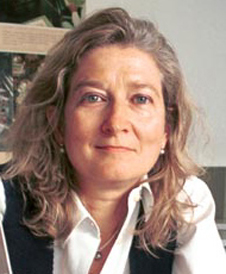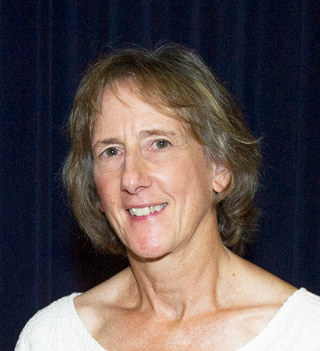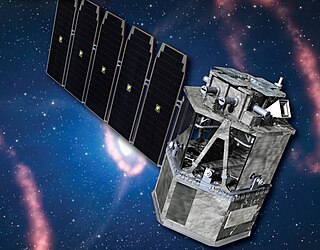Related Research Articles

The Goddard Space Flight Center (GSFC) is a major NASA space research laboratory located approximately 6.5 miles (10.5 km) northeast of Washington, D.C., in Greenbelt, Maryland, United States. Established on May 1, 1959, as NASA's first space flight center, GSFC employs about 10,000 civil servants and contractors. Named for American rocket propulsion pioneer Robert H. Goddard, it is one of ten major NASA field centers. GSFC is partially within the former Goddard census-designated place; it has a Greenbelt mailing address.

The Fermi Gamma-ray Space Telescope, formerly called the Gamma-ray Large Area Space Telescope (GLAST), is a space observatory being used to perform gamma-ray astronomy observations from low Earth orbit. Its main instrument is the Large Area Telescope (LAT), with which astronomers mostly intend to perform an all-sky survey studying astrophysical and cosmological phenomena such as active galactic nuclei, pulsars, other high-energy sources and dark matter. Another instrument aboard Fermi, the Gamma-ray Burst Monitor, is being used to study gamma-ray bursts and solar flares.
Reuven Ramaty (1937—2001) was a Hungarian astrophysicist who worked for 30 years at NASA's NASA Goddard Space Flight Centre. He was a leader in the fields of solar physics, gamma-ray line spectrometry, nuclear astrophysics, and low-energy cosmic rays. Ramaty was a founding member of NASA's High Energy Solar Spectroscopic Imager which has now been renamed the Reuven Ramaty High Energy Solar Spectroscopic Imager in his honour. This was the first space mission to be named after a NASA scientist and was operational from 2002 until 2018. The Online Archive of California holds over 400 entries for documents, papers and photographs published by and of Ramaty and his work. Ramaty made many contributions in the field of astrophysics and solar physics. He was given the Goddard Lindsay Award in 1980 and had a tribute dedicated to his work at the University of Maryland in 2000.

John Cromwell Mather is an American astrophysicist, cosmologist and Nobel Prize in Physics laureate for his work on the Cosmic Background Explorer Satellite (COBE) with George Smoot.

Jean Hebb Swank is an astrophysicist who is best known for her studies of black holes and neutron stars.

Cornelis A. "Neil" Gehrels was an American astrophysicist specializing in the field of gamma-ray astronomy. He was Chief of the Astroparticle Physics Laboratory at NASA's Goddard Space Flight Center (GSFC) from 1995 until his death, and was best known for his work developing the field from early balloon instruments to today's space observatories such as the NASA Swift mission, for which he was the principal investigator. He was leading the WFIRST wide-field infrared telescope forward toward a launch in the mid-2020s. He was a member of the National Academy of Sciences and the American Academy of Arts and Sciences.

Goddard Space Flight Center (GSFC) is NASA's first, and oldest, space center. It is named after Robert H. Goddard, the father of modern rocketry. Throughout its history, the center has managed, developed, and operated many notable missions, including the Cosmic Background Explorer, the Hubble Space Telescope, the Tracking and Data Relay Satellite System (TDRSS), the Lunar Reconnaissance Orbiter, and the Solar Dynamics Observatory.

Gerald Jay (Jerry) Fishman is an American research astrophysicist, specializing in gamma-ray astronomy. His research interests also include space and nuclear instrumentation and radiation in space. A native of St. Louis, Missouri, Fishman obtained a B.S. with Honors degree in physics from the University of Missouri in 1965, followed by M.S. and Ph.D. degrees in space science from Rice University in 1968 and 1970, respectively.

Frank Bethune McDonald was an American astrophysicist who helped design scientific instruments for research flights into space. He was a key force behind several initiatives and programs of the National Aeronautics and Space Administration, for which he served as chief scientist.
Kosmos 1805 was a Soviet electronic intelligence satellite which was launched in 1986. The first of four Tselina-R satellites to fly, it was constructed by Yuzhnoye with its ELINT payload manufactured by TsNII-108 GKRE. Since it ceased operations it has remained in orbit as space junk, and in April 2012 NASA's Fermi Gamma-ray Space Telescope was forced to maneuver to avoid a collision with the derelict satellite.

Patrizia Caraveo is an Italian astrophysicist.

Alice Kust Harding is an American astrophysicist at the NASA Goddard Space Flight Center, Greenbelt, Maryland.
Lynn Cominsky is an American astrophysicist and educator. She was the Chair of Astronomy and Physics at Sonoma State University in Rohnert Park, California from August 2004 through August 2019. She is currently the Project Director for the NASA Education and Public Outreach Group.
Carole Mundell is an observational astrophysicist who researches cosmic black holes and gamma ray bursts.

Rita M. Sambruna Commander OMRI (Hon) is an Italian-American astrophysicist and is the Deputy Director of the Astrophysics Science Division at National Aeronautics and Space Administration's (NASA) Goddard Space Flight Center. From September 2022 to May 2023, she was the Acting Deputy Director of the Science Exploration Directorate at Goddard. Rita held the Clare Boothe Luce Professorship in Physics and Astronomy at George Mason University in 2000-2005.

Anne L. Kinney is an American space scientist and educator. Kinney is currently the Deputy Center Director at NASA Goddard Space Flight Center. Previously, she held positions as the head of the Directorate for Mathematical and Physical Sciences (MPS) for the National Science Foundation (NSF), the Chief Scientist of the W.M. Keck Observatory, Director of the Solar System Exploration Division at NASA Goddard Space Flight Center, Director of the Origins Program at NASA Jet Propulsion Laboratory, and Director of the Universe Division at NASA Headquarters. She earned a bachelor's degree in astronomy and physics from the University of Wisconsin-Madison and a doctorate in astrophysics from New York University, and has published more than 80 papers on extragalactic astronomy. She was an instrument scientist for the Faint Object Spectrograph that flew on the Hubble Space Telescope.
Reshmi Mukherjee is an Indian-American astrophysicist known for her research on gamma-ray astronomy and blazars, involving work based on the Compton Gamma Ray Observatory, VERITAS, Energetic Gamma Ray Experiment Telescope (EGRET), and Cherenkov Telescope Array collaborations. She is Helen Goodhart Altschul Professor of Physics & Astronomy at Barnard College.
Brenda Lynn Dingus is an American particle astrophysicist at the Los Alamos National Laboratory, known for her research on gamma-ray bursts and cosmic rays.
Elizabeth Anne Hays is an American astrophysicist at the NASA Goddard Space Flight Center, where she is chief of the Astroparticle Physics Laboratory and the project scientist for the Fermi Gamma-ray Space Telescope. Her research has included gamma-ray astronomy of the Crab Nebula, novae, and gamma-ray bursts.

The Compton Spectrometer and Imager (COSI) is a NASA SMEX astrophysics mission that will launch a soft gamma-ray telescope in 2027. It is a wide-field compact Compton telescope (CCT) that is uniquely suited to investigate the "MeV gap". It provides imaging, spectroscopy, and polarimetry of astrophysical sources, and its germanium detectors provide excellent energy resolution for emission line measurements.
References
- 1 2 3 4 Administrator, NASA Content (2017-10-16). "Julie Mc Enery - Fermi Project Scientist and Astrophysicist". NASA. Retrieved 2020-07-22.
- ↑ O'Donovan, Brian (2019-03-12). "Reaching for the Stars: From Dublin to Outer Space".
{{cite journal}}: Cite journal requires|journal=(help) - ↑ "DR JULIE MCENERY". UCD Alumni Awards. Retrieved 2020-07-22.
- ↑ "Julie McEnery Elected Fellow of the American Physical Society - Joint Space-Science Institute". jsi.astro.umd.edu. Retrieved 2020-07-22.[ dead link ]
- ↑ "DR JULIE MCENERY". UCD Alumni Awards. Retrieved 2022-09-02.
- 1 2 "McEnery Medal and Prize" . Retrieved 2022-08-20.
- ↑ Studio, NASA Scientific Visualization (2013-04-30). "NASA Scientific Visualization Studio | When Fermi Dodged a 1.5-ton Bullet". NASA Scientific Visualization Studio. Retrieved 2024-09-06.